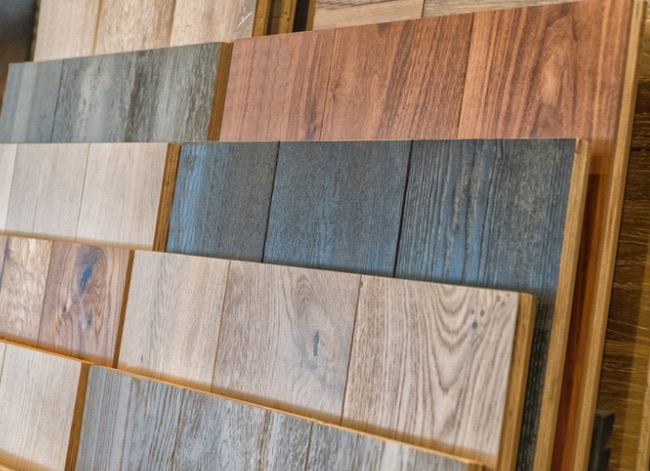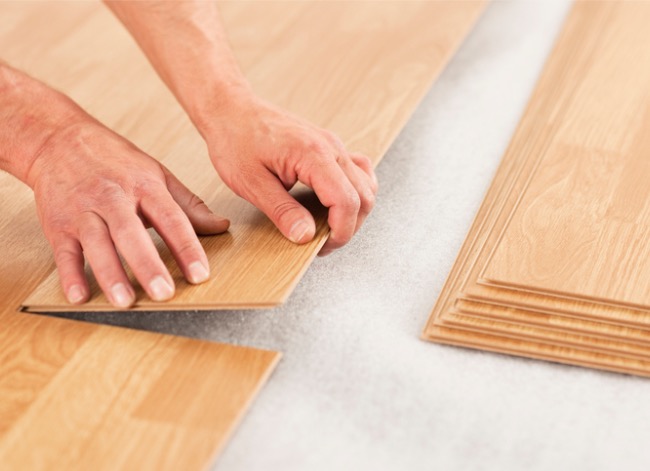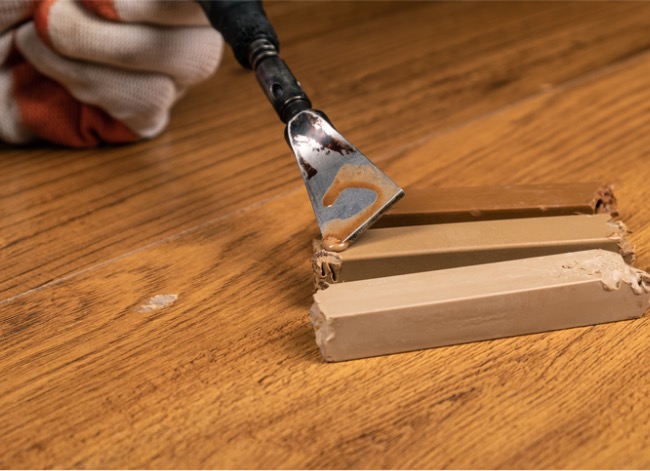

We may earn revenue from the products available on this page and participate in affiliate programs. Learn More ›
If you have dated, worn floors, you might be considering freshening them up with new flooring. A quick search of the internet for flooring products can reveal the raging debate between engineered hardwood and laminate flooring. Which one should you choose? And why?
The answers are relative, as there are great reasons to choose either for specific situations. Plus, both types of flooring are offered in a range of options, are easy to install, and can create a fresh new look.
Keep reading to learn more about both of these flooring types so you can make the best decision between engineered hardwood and laminate flooring.
Engineered hardwood flooring looks more like real wood.
Engineered hardwood flooring often looks more like real wood than laminate. And there’s a great reason: It is real hardwood flooring. Well, the topmost layer is hardwood.
Engineered hardwood flooring consists of a thin layer of hardwood material glued to a substrate made from strips of wood. The manufacturers orient those strands in perpendicular layers, allowing each layer to expand and contract while still remaining stable.
This is a far more stable and typically affordable approach to hardwood, as only the top layer is the expensive hardwood. The sublayers are typically aspen, pine, or other softwoods that cost much less for the manufacturer.
RELATED: The Best Engineered Wood Flooring

Laminate flooring can look like wood, stone, ceramic, and more.
Laminate flooring is an entirely different animal than engineered hardwood. While these floors can look like hardwood, they can also look like stone, ceramic, or really any material the manufacturer wishes.
Generally speaking, a laminate floor consists of four layers. The bottom layer is typically cork or foam, and it creates a soft, quiet substrate that helps resist moisture (though older or cheaper flooring options might not have this layer, requiring a moisture barrier or foam underlayment). The next layer up is a high-density fiberboard. Above that is a thin layer of a decorative paper-like material with the design printed on it. The final layer is known as the wear layer, and it’s a clear protectant that can take wear from shoes and chair legs.
It’s the printed, decorative layer that allows laminate flooring to look like almost any material the manufacturer wishes. It’s not much more than a large sticker.
Both are durable flooring options, but engineered hardwood requires more maintenance.
Both engineered hardwood and laminate flooring are tough and durable enough for anything a standard hardwood floor can handle. Engineered hardwood does have a few more maintenance requirements, however.
Engineered hardwood is still hardwood flooring, so it requires many of the same maintenance and upkeep tasks. As an example, spills or leaks need immediate cleaning, just like a traditional hardwood floor. Otherwise, the flooring can soak up the liquid and swell. Also, it’s important to apply a layer of wax from time to time to protect the finish and prevent the floor from soaking up moisture.
But on the other hand, the increased degree of maintenance can be a good thing. Most engineered hardwood floors can be refinished, allowing DIYers to remove the wear layer and create a fresh, clean look with refinishing products.
RELATED: How to Install Laminate Flooring
Laminate flooring is more affordable than engineered hardwood.
Laminate floors don’t typically cost as much to purchase as engineered hardwood products. Almost all of the materials used in laminate flooring are man-made or simply remanufactured. For example, the high-density fiberboard is a mixture of sawdust and glues or resins that undergoes extreme compression in a factory. This process takes a fraction of the time and materials involved in felling a hardwood tree and milling it for flooring.
And engineered hardwood comes in a variety of species that can affect the cost tremendously. Oak might be relatively affordable, while a more luxurious wood like cherry or mahogany can cost twice as much. With a laminate floor, the “wood” layer is just a printed sticker, allowing all laminate to be competitively priced.
Engineered hardwood is better for resale value.
At this point, it shouldn’t come as a surprise that engineered hardwood floors would improve a home’s resale value more than laminate. It can be almost impossible to distinguish an engineered hardwood floor from a traditional hardwood floor, as they are the same on the surface and homeowners can refinish them.
There is also a perceived notion that laminate flooring isn’t as durable or that it’s a lower-quality material. While it’s true that laminate might not contain hardwood or stone, the reality is that a laminate floor can actually be more durable than engineered. But for those who prefer real wood, many are willing to pay a bit more for it.
Laminate is best for DIY installation.
Both engineered hardwood and laminate flooring are fairly easy to install, but laminate flooring tends to be slightly easier for DIYers. Engineered hardwood flooring often requires gluing the material in place, while laminate flooring can usually float, making it a true lock-and-drop solution.
Also, the materials used in laminate flooring are typically easier to cut than those in engineered hardwood. Laminate flooring can often be scored and snapped to length with guillotine-style flooring cutters that are very easy to use.
Cost is also a reason why laminate flooring is more DIY-friendly. Any mistakes are much less costly than they would be with an expensive engineered hardwood product.

Both flooring options are better at water resistance than traditional hardwood.
Whichever choice you go with, both options are more water-resistant than a traditional hardwood floor, though the edge certainly goes to laminate. The wear layers on top of both of these floors seal water out, but laminate flooring’s man-made materials are more impervious to water than wood.
The protective coat will keep water from soaking into the pores on the surface of the hardwood, but if the water makes it through the seams, the hardwood will wick it up and cause swelling. The seams between laminate flooring strips are typically more waterproof, and if water does make it through, it’s less likely to wick into the material.
RELATED: 7 Ways You May Be Ruining Your Hardwood Floors
Engineered hardwood floors are easier to repair.
As mentioned earlier, one of the great benefits of engineered hardwood floors is that they can be repaired. Most products are incredibly durable from the start, with a layer of aluminum oxide protecting the finish, but if a deep scratch penetrates the wood, all is not lost as it would be with a laminate floor.
For smaller scratches and repairs, a floor repair wax that matches the shade of the floor is all that’s required. Simply apply it to the scratch according to the directions and buff it until the scratch is no longer visible.
For deeper scratches or larger areas, it might be necessary to strip off the aluminum oxide coating. This requires a flooring sander with special sanding belts embedded with ceramic or other abrasives, but the refinishing process is exactly the same as a standard hardwood floor.

Laminate floors are better for pet owners.
Pets are wonderful, furry additions to the family, but they do have a way of causing mischief. Their nails can easily scratch a floor, and they might even leave a wet little mess behind from time to time.
Given its water-resistant nature, affordability, and general wear-resistance, laminate floors are better for pet owners. They require less upkeep than an engineered hardwood floor, and in many cases, they’re more durable. Nails aren’t as likely to dig into a laminate floor during playtime, and if they make a little puddle, pet owners will have more time to mop it up before damage sets in.

